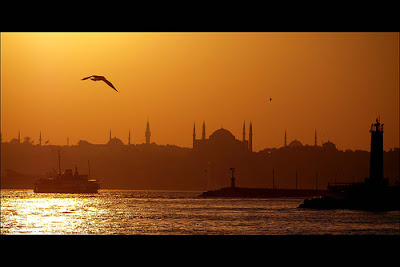The Dardanelles, Istanbul, the Bosphorus and into the Black Sea.

 ISTANBUL
ISTANBUL"PAMIR"
When we sailed from Split on the Dalmatian coast we were faced with a dirty, difficult, and dangerous spell of work in preparing the ship to load a full cargo of wheat from the Caucasus. The dirty part was cleaning the ship after discharging 10,000 tons of black dusty coal taken out by cranes with grabs and spilling dust everywhere.The dangerous part was erecting shifting boards the length of the ship and then creating a series of wooden bins. Grain is a dangerous cargo.The angle of repose of most grain is about 50 degrees and there is an 8% settlement on passage. I well remember the laborious and sometimes precarious task of erecting shifting boards while on passage across to be ready to load on arrival in one of the grain ports. Weather was seldom ideal for straddling the tweendeck and main deck beams in order to bolt the uprights for the shifting boards and feeders to the beams, the uprights swinging around on the end of a runner while the ship is rolling. The task of fitting the boards in the lower holds, the feeders and bins was comparatively safe. Then after discharge all the boards were retrieved and the uprights dismantled and stowed in the tween decks in readiness for loading the next cargo. These tasks were often performed in equally inclement weather, especially in winter.
Owners tried many ploys to circumvent the International Carriage of Grain regulations and the expense of fitting out for bulk wheat, barley, and other seeds and pulses. The sad loss of Pamir in 1957 was caused by an experimental stow of bulk grain. The Pamir 's stow was to load bulk grain, trim it level, and then over-stow it with 8 tiers of bagged grain. This stow was conceived ashore in a laboratory to save money, unfortunately the laboratory was not The Western Ocean. The cargo shifted and this beautiful sailing vessel capsized in the tail end of a hurricane with 6 survivors.
We sailed into the Dardanelles, an almost featureless coast, and the scene of terrible slaughter in the First World War. We traversed the Sea of Marmara and into the Bosphorus to anchor off Istanbul. There we picked up instructions and the latest data to navigate safely to Novorossiysk in the Soviet Union; this area was still mined in 1950's and vessels had to keep to strict marked routes.
Istanbul was all that I had hoped; it would have great to have gone ashore. The sky-line in the old port is magnificent with the great dome of the mosque and Sta. Sofia. The vessels and small craft that thronged the area all seemed to come from another era; even the scent of the land seemed to capture the very sense of history. It is truly one of the world's great ports.
Comments